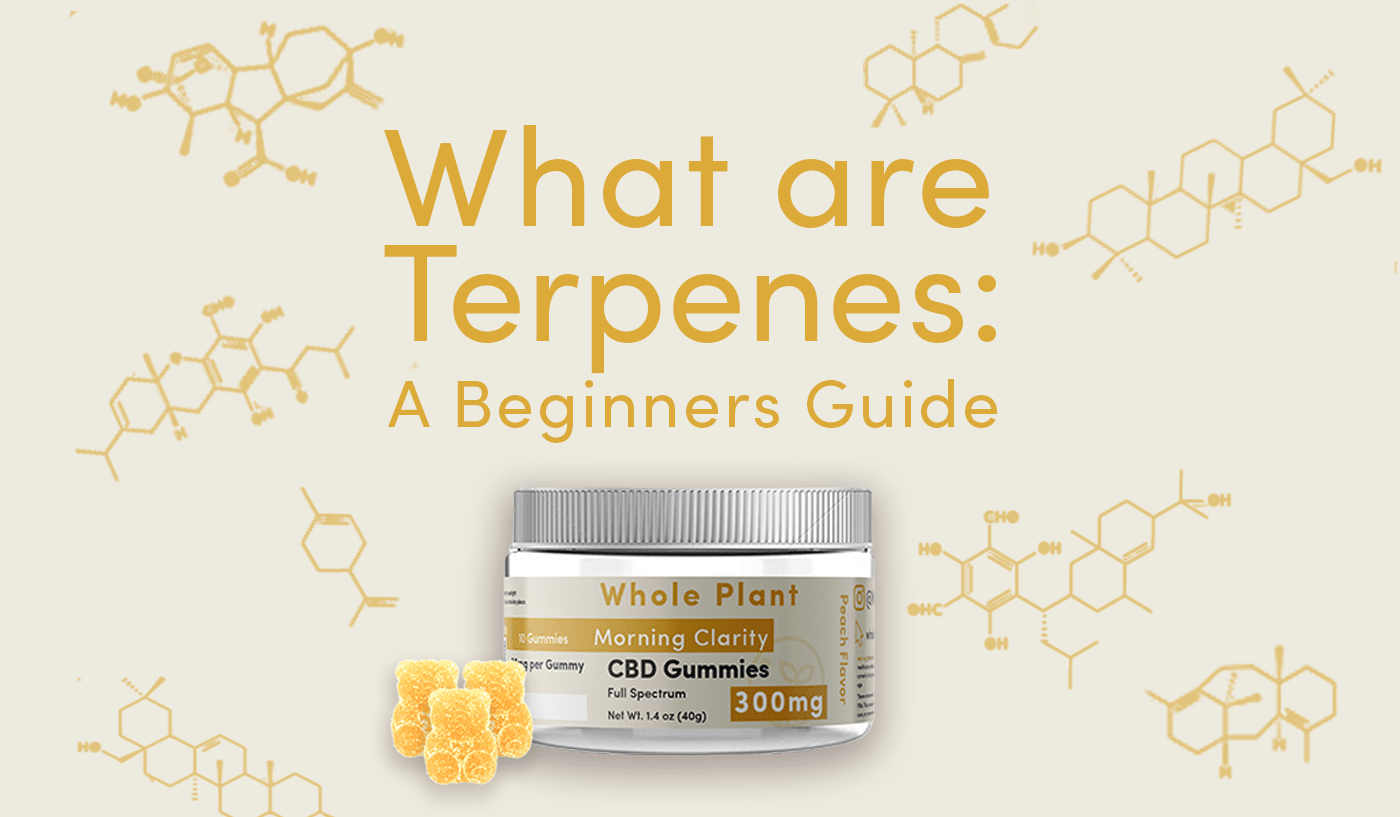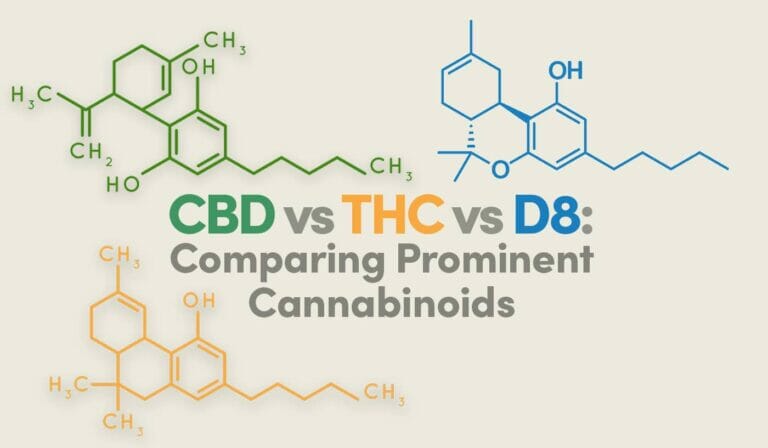The smell you smell when you walk into a forest is made up of all different types of trees. Those smells come from the compounds that give plants, foods, and flowers their distinctive smell and special everlasting aromas.
These compounds are known as a group of natural aromatic hydrocarbons called Terpenes. In this blog, we will take a look at what a terpene compound is, the types of terpenes that exist, the effects of terpenes, and examples of different common terpenes.
What Are Terpenes?
In recent years, there has been a lot of buzz about terpenes. But what are they? Terpenes are the molecules responsible for the odors and flavors associated with different plants. In cannabis and hemp, they can be found most notably in the trichomes on the flowers.
In fact, these molecules are considered to be one of the main contributors to a strain’s specific flavor and aroma. The word terpene is derived from the Greek word for “terpentine/turpentine” referring to the substance as resin-like.
What Are Terpenes Used For?
Terpenes are found in all plants and help to protect the tissue of the plant from external threats (i.e., insects and other pests). These same properties can also sometimes be found in their plant products.
They have a wide range of additional human uses ranging from fragrances to more medicinal purposes. They can be used as a natural flavor enhancer for food and beverages, as well as a preservative in certain forms. Lastly, they are utilized in the production of aromatherapy oils for natural healing techniques.
Benefits of Terpenes
Terpenes are the building blocks of essential oils and provide a range of health benefits. When comparing terpenes to the essential oils they come from, it is clear that there is something more than just an aroma coming from them.
These compounds are first produced by plants to protect themselves from various environmental stresses, bugs, and diseases. Terpenes have beneficial effects on humans including many therapeutic uses including aromatherapy and medical marijuana.
How Are Terpenes Different From Cannabinoids?
Cannabinoids are the more commonly talked about components in hemp and cannabis that react with our bodies’ endocannabinoid system. The most notable recently are Delta-9 THC, CBD, CBG, CBC, CBN, and Delta-8 THC. These compounds are different than terpenes because some of these are considered intoxicating, like THC. Terpenes are considered non-intoxicating although their effect on our bodies is still being explored.
THC and other cannabinoids are also responsible for providing relief for numerous different medical conditions in the form of medical marijuana. While CBN is mildly psychoactive, it is considered non-intoxicating. (3) It also has a specific relationship with THC as CBN is a byproduct of THC oxidation.
Types of Terpenes
There are many different types of terpenes, but they all have a common molecular structure of an isoprene unit linked with another unit called a monoterpene or sesquiterpene.
Another important dimension of distinction in terms of terpenes is where they derive from. Next, we shall explore how the main two types differ then take a special look at where they are found.
Medical Terpenes vs. Botanical Terpenes
Terpenes can be used as a form of medicine or as a method of flavoring for food production. Typically, medical terpenes are used to help relieve symptoms of certain diseases and conditions. Whereas, botanical terpenes are used to provide flavor to food or are added into some types of cosmetics.
Although the definitions of these two have some overlap and can sometimes be used interchangeably, medical primarily refers to raw natural terpenes derived from hemp or cannabis flower.
What Are Natural Terpenes in Cannabis and Hemp?
Terpenes are becoming a hot topic due to unique combinations within the hemp and cannabis plant. Natural plant terpenes from hemp and cannabis, also sometimes referred to as “live terpenes”, provide specific profiles that are made up of numerous different terpenes.
The terpene profile of a hemp flower may include citrus, pine, mint, or other aromatics. These intricate profiles are determined by the combination of terpenes present in the plant. The interaction between these terpene molecules can create new flavors that would not be possible alone as single compounds. Similar to the color spectrum, natural terpene expression provides an ability to explore wide variations.
Where They Are Found in the Cannabis and Hemp Plant?
Terpenes are found inside the trichome glands of the plant and reside near the plant’s cell walls where they create a variety of smells. Trichome glands are found on the flowers, leaves, and stems of plants. When looking under a lens, like an x30 loupe, they look like an amber or milky-white ball at the top of a narrow stalk. Inside that little sphere, all of the terpenes and cannabinoids are located.
What are CBD terpenes?
CBD terpenes are a type of terpene that is present in hemp flowers, leaves, and stems. When processed into crude oil it results in a high CBD and terpene content that may be used in numerous ways later on.
What are Strain-Specific Terpenes?
Strain-specific terpenes are the compounds that give hemp and cannabis their notable characteristics. When a product is called strain-specific that refers to the combination of the profile is true to the original plant by means of its terpene ratio.
In fact, these molecules are considered to be one of the important contributors to a strain’s specific effects in addition to the flavor and aroma. At Whole Plant™ we used the strain-specific ideology to create our Sativa – GO, Hybrid – SOCIAL, and Indica – RELAX product collections. Each time when you use our products, you can enjoy knowing that the terpene profiles are strain-specific to help you reach your wellness goals.
Effects of Terpenes
Terpenes contribute to the “entourage effect.” The entourage effect refers to the synergistic combination of cannabinoids, terpenoids, and flavonoids present in hemp and cannabis that interacts with our bodies’ Endocannabinoid System. This system is made up of neurotransmitters that send signals to the brain and around the body to help maintain homeostasis. These endocannabinoids are responsible for regulating mood, pain sensation, appetite, and more with our Endocannabinoid System. (4)
What Terpenes Are in Sativa?
There is no one size fit for certain terpenes that are always found in Sativa varieties. However, typical terpenes associated with an uplifting effect are Limonene, Ocimene, and Valencene. Usually, if you are unsure and need a rule of thumb for when making a selection. Citrus varieties will most often be uplifting and pair well with breakfast too.
What Terpenes Are in Indica?
Similarly, with Indica there is not a one size fits all for certain terpenes that are always found in Indica varieties. Typical terpenes associated with sedating effects are Myrcene, Beta-Caryophyllene, Limonene, and Linalool to name a few. When selecting a consumer product, it is the most surefire method to rely on the terpene percentages from lab testing instead of solely relying on a strain name or brand name.
Do They Get You High?
Terpenes are not usually thought to be intoxicating, especially in comparison to some of the cannabinoids found in hemp and cannabis. They do interact with the CB1 and CB2 receptors of the Endocannabinoid System which shows an interaction occurring that we have yet to understand.
How Do They Make You Feel?
Terpenes have a chemical effect on our bodies—they act like a lock and key system in the body. It is marvelous the ways in which the human body works to regulate ourselves without our conscious awareness of it.
What Are the Different Terpenes Found in CBD Oil?
Myrcene
Myrcene is a terpene that provides a spicy, earthy, and fruity aroma. Strains with high Myrcene levels usually produce a more sedative effect.
Beta-Caryophyllene
Beta-Caryophyllene is the primary terpenoid compound found in hops and some other plants, including hemp and cannabis (Cannabis sativa L.). Beta-Caryophyllene is one of more than two hundred terpenes found in the hemp plant that provides therapeutic benefits to many different symptoms. This molecule is also found in the essential oils of cloves that are used for aromatherapy. The terpene has been discovered to have anti-inflammatory properties and has been shown to help reduce alcohol intake. (1)(2)
Limonene
Limonene is a natural terpene that can be found in lemon oil, grapefruit oil, orange peels, celery seed extract, and other plants. It is known for its powerful citrus scent reminiscent of orange peels and lemon zest. Some users have reported an improvement in mood, energy, and focus during an experience with limonene. Although, since it is usually not isolated, the effects can vary because of the inert compounds that may be partnered within products.
Pinene
Pinene is a monoterpene that is found in many plants and trees, especially conifers. It is one of the two main types of compounds that give pine trees their characteristic smell. There are two main structures, alpha, and beta isomer types. These isomers are very prominent components of turpentine.
Linalool
In its raw form, it is a colorless liquid with a floral, sweet odor. It is a very common smell for gardeners as it is in many varieties of wildflowers and other more prominent species. For example, linalool is found in lavender in abundance. This is very reflective of its smell when isolated.
Humulene
Humulene is the second most abundant terpene in hop flowers and one of two essential components (along with myrcene) of many different types of beers and specialty beverages.
Ocimene
Ocimene is a hydrocarbon with a perfume-like smell, often used in perfumes and cosmetics. For plants, it is also known as one of the best terpenes for pest resistance against several different types of insects.
Valencene
The name is a reference to Valencia, a region of Spain where the Valencia orange plant originates. Valencene is known to be a major contributor to terpene expression in grapefruits. It is used in personal care products, cosmetics, and cleaning products for its citrus essence.
Other Notable Terpene Compounds in Hemp
A few other notable terpenes that are found in hemp include:
- Farnesene
- Terpineol
- Geraniol
- Borneol
- Bisabolol
Summary
Terpenes are a significant part of our world and they have yet to be fully explored and discovered even. As we find and classify new compounds it is becoming increasingly important in our understanding of the world around us and how we interact with it. In this blog, we discussed what a terpene compound is, the types of terpenes that exist, the effects of terpenes, and examples of different common terpenes.
Resources:
- Gertsch J, Leonti M, Raduner S, et al. Beta-caryophyllene is a dietary cannabinoid. Proc Natl Acad Sci U S A. 2008;105(26):9099-9104. doi:10.1073/pnas.0803601105
- Al Mansouri S, Ojha S, Al Maamari E, Al Ameri M, Nurulain SM, Bahi A. The cannabinoid receptor 2 agonist, β-caryophyllene, reduced voluntary alcohol intake and attenuated ethanol-induced place preference and sensitivity in mice. Pharmacol Biochem Behav. 2014;124:260-268. doi:10.1016/j.pbb.2014.06.025
- Morales P, Hurst DP, Reggio PH. Molecular Targets of the Phytocannabinoids: A Complex Picture. Prog Chem Org Nat Prod. 2017;103:103-131. doi:10.1007/978-3-319-45541-9_4
- Mouslech Z, Valla V. Endocannabinoid system: An overview of its potential in current medical practice. Neuro Endocrinol Lett. 2009;30(2):153-179.



